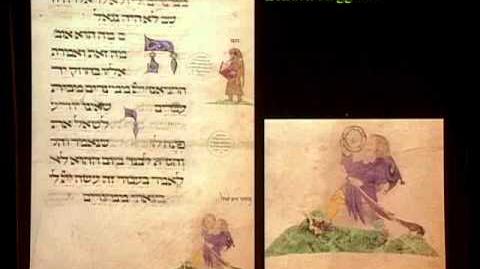|
|
|
|
איורי ההגדה של פסח - יואל בן סימון |
'Washington Haggadah: The Life of a Jewish Book metmuseum |
המצגת הראשונה[]
נכתב ביו-טוב: Katrin Kogman-Appel, Evelyn Metz Memorial Research Chair in Art, Ben-Gurion University of the Negev, Beer Sheva, Israel
מצגת זו כוללת את ההגדה בוושינגטון, אחד מכתבי היד המאוירים החשוב ביותר עברית לגובה באוסף הקהל האמריקאית הלוואה חסרת תקדים של ספריית הקונגרס. ההגדה היא ספר השתמשו ב ליל הסדר, הארוחה טקס זה מציין את יציאת בני ישראל ממצרים העתיקה. למרות המרכיבים החיוניים של הטקסט הוקמו במאה השנייה, את ההגדה הראשונה נעשתה תוך עצמאית, מאויר הספר בימי הביניים.
עם שובה תמונות טמפרה וזהב על קלף, הגדת וושינגטון נושא את התאריך 29 ינואר 1478, ולאחר החתימה של הסופר הנודע המאייר יואל בן שמעון. נולד בקלן סביב 1420, עבד יואל בן שמעון הן גרמניה וצפון איטליה. עשרת כתבי יד עבריים בחתימתו שלו לשרוד, הגדות היו משהו של התמחות. פרטים מסוימים של הטקסט של ההגדה בוושינגטון כולל הפניה המוקדמת, ספציפית חזרת כמו עשב מריר לשמש ב-הארוחה להבדיל את הספר הזה כאחד נוצר תוך יואל בן שמעון היה לעבוד בגרמניה.
ההגדה מציעה במיוחד עדות חזקה לחיוניות של אמנות חזותית בחיים היהודיים. בשוליה להציג תיאורים רבים של יהודים מימי הביניים בהכנות והשתתפות ליל הסדר: הסרת חמץ מהבית הבוער בו, כבש צלייה, ושתיית יין.
ההגדה מוצגת לצד עבודות של ימי הביניים, אמנות מדיה אחרים, כולל כלי זכוכית וקרמיקה גרמנית איטלקית דומות לאלו המוצגות בכתב היד.
בקרב כמעט עשרים אלף ספרים עבריים בספריית הקונגרס (המוקדם אשר באים מספריית תומס ג 'פרסון), הגדת וושינגטון, שנרכשו לפני 1920, היא בעלת חשיבות ייחודית בתור יצירת אמנות. הצגתו במוזיאון המטרופוליטן חונכת סדרה של הלוואות, אשר כל אחד מהם יתמקד כתב יד אחד, מואר עברית של ימי הביניים, אשר יתקיים במהלך שלוש השנים הקרובות בגלריות הביניים בבניין הראשי של האמנות. הלוואה לכל יוגדר בהקשר של אוצרות הקשורים מהאוסף של המוזיאון.
המקור[]
This presentation features the Washington Haggadah, one of the most important illustrated Hebrew manuscripts preserved in an American public collection and an unprecedented loan from the Library of Congress. A Haggadah is the book used at the Passover seder, the ritual meal that commemorates the exodus of the ancient Israelites from Egypt. Although the essential components of the text were established in the second century, the Haggadah was first made into an independent, illustrated book in the Middle Ages.
With captivating images in tempera and gold on parchment, the Washington Haggadah bears the date January 29, 1478, and the signature of the renowned scribe and illuminator Joel ben Simeon. Born in Cologne around 1420, Joel ben Simeon worked in both Germany and northern Italy. Ten Hebrew manuscripts bearing his signature survive, and haggadot were something of a specialty. Certain details of the text of the Washington Haggadah—including an early, specific reference to horseradish as the bitter herb to be used at the meal—distinguish this book as one created while Joel ben Simeon was working in Germany.
The Haggadah offers particularly strong testimony to the vitality of visual arts in Jewish life. Its margins display numerous depictions of medieval Jews preparing for and participating in the seder: removing leavened bread from the house and burning it, roasting the lamb, and drinking wine.
The Haggadah is displayed alongside medieval works of art in other media, including German glass vessels and Italian ceramics similar to those shown in the manuscript.
Among nearly twenty thousand Hebrew books in the Library of Congress (the earliest of which come from Thomas Jefferson's library), the Washington Haggadah, purchased before 1920, is of unique importance as a work of art. Its presentation at the Metropolitan Museum inaugurates a series of loans, each of which will focus on a single, illuminated medieval Hebrew manuscript, that will take place over the next three years in the Main Building's medieval art galleries. Each loan will be set in the context of related treasures from the Museum's collection.
המצגת השנייה[]
David Stern, Moritz and Josephine Berg Professor of Classical Hebrew Literature, University of Pennsylvania
This presentation features the Washington Haggadah, one of the most important illustrated Hebrew manuscripts preserved in an American public collection and an unprecedented loan from the Library of Congress. A Haggadah is the book used at the Passover seder, the ritual meal that commemorates the exodus of the ancient Israelites from Egypt. Although the essential components of the text were established in the second century, the Haggadah was first made into an independent, illustrated book in the Middle Ages. With captivating images in tempera and gold on parchment, the Washington Haggadah bears the date January 29, 1478, and the signature of the renowned scribe and illuminator Joel ben Simeon. Born in Cologne around 1420, Joel ben Simeon worked in both Germany and northern Italy. Ten Hebrew manuscripts bearing his signature survive, and haggadot were something of a specialty. Certain details of the text of the Washington Haggadah—including an early, specific reference to horseradish as the bitter herb to be used at the meal—distinguish this book as one created while Joel ben Simeon was working in Germany.
The Haggadah offers particularly strong testimony to the vitality of visual arts in Jewish life. Its margins display numerous depictions of medieval Jews preparing for and participating in the seder: removing leavened bread from the house and burning it, roasting the lamb, and drinking wine.
The Haggadah is displayed alongside medieval works of art in other media, including German glass vessels and Italian ceramics similar to those shown in the manuscript.
Among nearly twenty thousand Hebrew books in the Library of Congress (the earliest of which come from Thomas Jefferson's library), the Washington Haggadah, purchased before 1920, is of unique importance as a work of art. Its presentation at the Metropolitan Museum inaugurates a series of loans, each of which will focus on a single, illuminated medieval Hebrew manuscript, that will take place over the next three years in the Main Building's medieval art galleries. Each loan will be set in the context of related treasures from the Museum's collection

